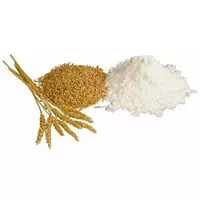Wheat flour

Wheat flour, which is obtained from wheat grains, is today one of the most popular types of flour, the main purpose of which is to bake bread and bakery products. In addition, thanks to the universal properties of wheat flour, its application in the culinary sphere is almost limitless.
Pancakes, pies, dough for dumplings, pasta, bakery and confectionery. . . this list can be continued for a long time. Everyone's favourite muffins, cakes, biscuits, gingerbread and waffles are simply impossible to make without this essential product. Wheat flour is also used as breading, for example, cutlets or fish. By the way, before use, it is recommended to carefully sift the flour for loosening, drying and enrichment with oxygen, which is necessary for good fermentation.
Nowadays, it is very difficult to imagine the life of a modern person without wheat flour and its products. Usually, when choosing bakery products, the consumer mainly pays attention to the color of the crumb, preferring a lighter one. But it should be borne in mind that the shade of fragrant crumb is directly related to the grade of wheat flour, on which its color directly depends.
Wheat flour varieties
The Russian flour milling industry today produces wheat flour of the following varieties:
wheat flour;
prime grade wheat flour;
first grade wheat flour;
second grade wheat flour;
wallpaper wheat flour.
Speaking of the concept of "wheat flour" does not mean at all a reduced or increased quality of the product compared to higher or lower varieties. In this case, we are talking about the fact that certain qualitative features of flour play a role in the purpose for various uses in nutrition.
Wheat flour varieties differ among themselves depending on the yield (the amount of flour obtained from a hundred kilograms of grain), color, ash content, varying degrees of grinding (particle size), the content of bran particles and the amount of gluten. By the way, the calorie content of wheat flour does not differ much depending on the variety.
Composition of wheat flour
The nutritional value and bakery properties of wheat flour depend on its chemical composition, which in turn is influenced by the composition of the starting material, that is, grain. Higher grades of flour are produced from the inner layers of wheat endosperm, and therefore the composition of wheat flour contains a huge amount of starch (carbohydrates) and proteins, the properties of which directly depend on the quality of the dough and, as a result, the bread baked from it. But proteins, fats, sugars, vitamins and minerals are concentrated in the peripheral parts of the grain.
Benefits of wheat flour
It is quite difficult to talk about the benefits of wheat flour, which directly depends on its variety. Many people, having studied its composition, claim that flour exceeds many other healthy foods in terms of the amount of macro and trace elements contained in it. But few people pay attention to the high content of carbohydrates, with the regular consumption of which a person begins to quickly recover, and not muscle, but fat mass grows.
That is why, when baking, experts recommend adding other less high-quality varieties, such as the second or first grade, to snow-white flour from prime grade wheat. At the same time, despite the darker crumb, aromatic pastries will acquire a new taste, and the benefits of wheat flour will multiply.
wheat flour 334 kCal
Energy value of wheat flour (Ratio of proteins, fats, carbohydrates - ju):
Proteins: 10.8 g (~ 43 kCal)
Fats: 1.3 g (~ 12 kCal)
Carbohydrates: 69.9 g (~ 280 kCal)
Energy ratio (bj | y): 13% | 4% | 84%
 Español
Español Français
Français Português
Português Русский
Русский 简体中文
简体中文 繁體中文
繁體中文 日本語
日本語 한국어
한국어 العربية
العربية Türkçe
Türkçe Қазақ
Қазақ Deutsch
Deutsch Italiano
Italiano Українська
Українська
